By: Kameron Bryn
I grew up in the fourth biggest city in Norway, Stavanger, which has a population approximately twice that of Redlands, California. The entire country’s population is around the size of San Bernardino. Norway is associated with democratic socialism, free healthcare, winter sports, oil, and fish. This is where I spent the first decade and a half of my life. “Why would you move here?” is something I hear a lot. In theory, Norway is the better place for someone with my condition: free healthcare, excellent social security, liberal laws, etc. And, while that is all true, it’s only half of the picture.
When I was 16, I moved to Redwood City, California—warm weather, excellent healthcare, diverse culture and population, friendly people, and a large LGBTQ+ population. The perfect escape from a cold and frigid Norway, and yet, it did little to ease my suffering.
In May 2014, I started suffering from chronic headaches and fatigue and was diagnosed with anemia. However, being the smart cookie that I am, I decided to not take my iron supplements as they caused even worse headaches and nausea. This led to a complete iron depletion in October. My entire body stopped functioning, I was hot all the time, I couldn’t think, and I barely had enough energy to move. I was a mess. I started on the iron tablets again, and while it helped a lot with the fatigue, I started experiencing aches. First once or twice a day, then several times a day, and then non-stop. My sister recognized it as Fibromyalgia. I was diagnosed in the spring of 2016. It was a long and harrowing journey.

Fibromyalgia is an old person’s disease. I’m chock-full of those. I got diagnosed with arthritis this summer at 19, and low tear production at nine. I was always too young. I often wondered if there were ways it could’ve been prevented. At my eighth birthday party, I was playing in a play-house and I suddenly I felt as though I couldn’t breathe. I was lying on my back, gasping for air. I had fits of nausea throughout my entire childhood. I got headaches frequently; it felt like tiny men doing construction inside my head. But these were things to ignore. That’s the Norwegian way—to ignore. Even when we went to the family physician, he seemed to have a hard time believing me. When my sister suspected fibromyalgia, it was dismissed. “I don’t want to diagnose you with that”. I was sent to psychiatry, and they confirmed it wasn’t psychosomatic, but he still refused to do more tests on me. There were reports of Norwegian teenagers who were put into induced comas due to paralyzing pain from over-exertion. Before my iron-depletion, I was in the rigorous International Baccalaureate (IB) Middle Years Program , choir, Model United Nations and fencing twice a week. Pain is something to be ignored.
My (undiagnosed) fibromyalgia made it so I only barely graduated from Middle Years Programme (MYP ), and my mother took me to see specialists. As specialists aren’t covered in free healthcare, it cost a couple hundred dollars for each test they did. The treatments were just as limited as their knowledge. They agreed that even though it’s likely that I have fibromyalgia, the diagnosis wouldn’t help much as the treatment would be the same, either with specialists or be put on a waitlist for one to three years for treatment by public healthcare. Stavanger is one of the best places to have a heart attack. Chronic illness? Not so much. Fall 2015 I started treatment at the Pain Clinic at Stanford Medical Center. They still refused to give me a proper diagnosis, but I was being seen by a psychologist, physical therapist, psychiatrist and acupuncturist. The treatment helped, but school… was a nightmare. I was doing the same IB program at the American public high school I went to, but IB at that school was IB on top of regular school. I left the IB program within the month. I was still very ill, and the concept of doing six hours of homework every night on top of eight hours of school didn’t agree with my fibromyalgia. I asked for accommodations, but the only thing they could grant me was homework extensions and a permanent hall pass.
That didn’t make much difference when I could barely get out of bed. After three months of brick and mortar, I unofficially dropped out. I transferred to an online school, but there was still a requirement of nine hours of schoolwork per day. No one had told me the American Dream translated to ‘grind until you die’.
I unofficially dropped out of online school in the spring and then studied hard and tested out of high school in the fall. Just in time to move to Southern California as there was nothing left for me in the Bay Area. My sister was attending the University of Redlands and was my greatest support system at the time, and it was great to be with her again. I spent the next year in limbo, trying to figure out what I could possibly do in my current state in a country that didn’t seem to want me, from a country that didn’t seem to want to help me.
I have since paved my own path and worked with people who did want me and did want to help me. I think a lot about my two cultures and how they’re ingrained in my DNA and psyche, as much as I try to withdraw from them. I take no pride in them, but I have great interest in them—in how they shaped me, and how they treated me, and people like me. How they helped me and how they hurt me; how my experiences are unique and how they are universal.
